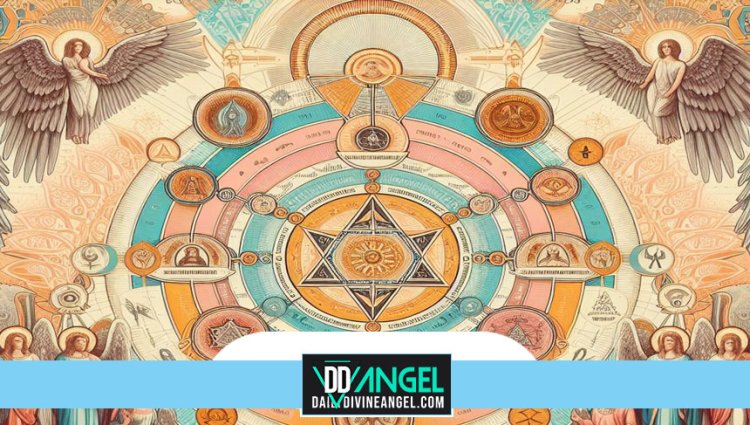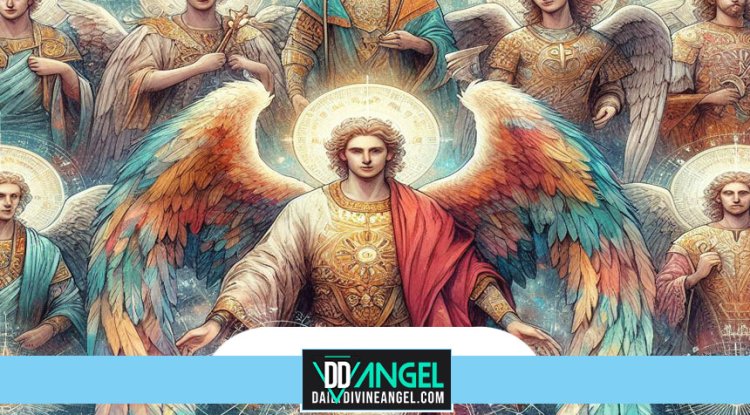Exploring the Depths of Archangelic Beliefs
Exploring Archangelic beliefs: Exploring the Depths of Archangelic Beliefs: A Guide to Spiritual Awakening Archangelic Beliefs

Archangelic beliefs have held an enormous place in the ideals, mythologies, and practices of diverse cultures throughout history. These celestial beings, regularly depicted as effective and benevolent messengers between the divine realm and humanity, embody a hard and fast set of virtues and traits that inspire awe and reverence. In this text, we delve into the world of archangelic ideals across remarkable cultures. From historic civilizations to indigenous traditions, from Japanese philosophies to Western mythologies, we can discover the origins, importance, and diverse interpretations of archangelic principles. Through examining their roles and effects, we aim to gain a deeper understanding of the normal enchantment and enduring legacy of archangelic beliefs.
introduction: Exploring Archangelic ideals
Welcome to a fascinating exploration of archangelic beliefs in fantastic cultures. At some point in history, various civilizations and traditions have respected effective celestial beings referred to as archangels. Those divine entities encompass virtues and values that hold substantial significance in their respective societies. In this text, we can delve into the origins, significance, and roles of archangels in distinct cultural beliefs and practices. Join us in this fascinating journey through time and space as we discover the archangelic influences that have shaped the cloth of splendid civilizations.
know-how Archangels: Origins and significance
Origins of Archangels
To virtually realize the archangelic ideals, it is crucial to explore their origins. Archangels discover their roots in diverse religious and mythological traditions around the sector. These celestial beings are regularly taken into consideration as intermediaries between the divine and humanity, bridging the space between heaven and earth. While their precise beginning stories might also fluctuate, there may be a commonplace perception that archangels are imbued with sizeable power and wisdom, making them worthy of reverence and adoration.
significance of Archangels in diverse Traditions
Archangels play giant roles in different traditions, symbolizing various beliefs and principles. In Christianity, for example, they are visible as messengers of God, tasked with handing over divine messages and carrying out essential missions. In other perception structures, like Judaism and Islam, archangels keep comparable roles of divine communique and guardianship. Moreover, archangels also discover their area in mythologies and folklore, where they encompass numerous virtues and often intrude inside the lives of mortal beings. Those extensive-ranging roles and significance show the enduring and widely-spread attraction of archangelic ideals.
Archangelic ideals in Cultural ideals and Practices
The Function of Archangels in Cultural Beliefs
Archangels have long been embedded in the material of cultural ideals, serving as symbols of steering, protection, and electricity. They are respected as celestial beings with the strength to intercede on behalf of people, offering help and divine intervention in instances of need. The influence of archangels extends beyond spiritual geographical regions, permeating various aspects of daily lifestyles and shaping the collective attention of societies.
Rituals and Ceremonies associated with Archangels
Cultural practices regularly contain rituals and ceremonies associated with archangels. Those ceremonies serve as avenues for connecting with the divine and looking for blessings, guidance, and safety. From complex ceremonies involving sacred chants, invocations, and services to non-public prayers and devotions, those rituals mirror the deep-seated belief in the electricity and presence of archangels. Such practices no longer only offer solace and a sense of belonging; they additionally foster a profound connection among people and the archangelic beliefs they represent.
Archangelic impacts on ancient Civilizations
Archangels in Mesopotamian Civilization
Archangelic effects may be observed inside the historic civilizations of Mesopotamia, in which celestial beings referred to as "appalled" were respected as divine sages and healers. Those appalled embodied expertise, supplying guidance and safety to humanity. Their presence in Mesopotamian beliefs showcases the iconic archangelic beliefs that have permeated human cultures since time immemorial.
Archangelic Connections in historical Egyptian tradition
In ancient Egyptian society, beings including the falcon-headed god Horus and the ibis-headed god Thoth could be visible as archangelic figures. The horus, associated with divine kingship and protection, symbolized the virtues of sovereignty and conquering adversity. Thoth, alternatively, represented know-how, writing, and magic, embodying the archangelic ideals of knowledge and verbal exchange.
Archangelic Affects on Greco-Roman Mythology
Greco-Roman mythology additionally showcases archangelic influences through deities like Hermes and Athena. Hermes, the messenger of the gods, possessed the potential to traverse between the divine and mortal geographical regions, embodying the archangelic best of verbal exchange and steerage. Further, Athena, the goddess of awareness and strategic struggle, represented the virtues of mind, awareness, and protection.
In the end, archangelic beliefs have left an indelible mark on outstanding cultures throughout history. These celestial beings, with their origins shrouded in mystery, retain the power to inspire and guide humanity, symbolizing virtues and principles held dear by one-of-a-kind societies. From their roles in cultural ideals and practices to their effects in historical civilizations, archangels have stood as effective symbols of divine connection, providing a glimpse into the profound dating between humans and the celestial realm.
Archangelic ideals in Indigenous Cultures
Archangelic standards in local American Traditions
In native American cultures, the idea of archangelic ideals can be observed in numerous bureaucracies. Native American tribes have long revered celestial beings and spirits that embody characteristics consisting of bravery, awareness, and protection. Those beings are frequently seen as intermediaries between humans and the non-secular realm. Even though the unique names and attributes may vary among tribes, the essence of archangelic beliefs is present in their notions, structures, and rituals.
Archangels in Aboriginal and Indigenous Australian Cultures
Similarly, Aboriginal and Indigenous Australian cultures have their own interpretations of archangelic beliefs. Dreamtime memories, which might be significant to Aboriginal spirituality, frequently feature powerful ancestral beings called "Wandjinas" or "Mimi spirits.". These beings are believed to have delivered order and concord to the land and retained them to guide and protect their humans. The reverence for these archangelic figures reflects the deep, non-secular connection that Indigenous Australians have with their ancestral roots.
Archangelic beliefs amongst African Indigenous communities
African indigenous groups also hold ideals in archangelic figures that encompass virtues and provide spiritual guidance. In diverse African traditions, there are tales and myths surrounding powerful deities or spirits that possess traits inclusive of electricity, wisdom, and recuperation capabilities. These archangelic ideals play substantial roles in rituals, ceremonies, and regular existence, shaping the ethical values and religious practices of African indigenous communities.
Archangelic concepts in Japanese Philosophies and Religions
Archangelic factors in Hinduism
Inside the rich tapestry of Hinduism, archangelic ideas may be visible in the shape of deities called "devas.". Those celestial beings are believed to have divine features and serve as intermediaries between the mortal realm and the gods. Devas characterize diverse elements of the natural world and human life, representing virtues that include righteousness, expertise, and protection.
Archangels in Buddhism and their Symbolism
In Buddhism, archangelic elements show up in the form of celestial beings called "devas" or "devatas.". Those beings are frequently depicted as guardians and protectors, guiding people on their religious paths. They signify virtues together with compassion, wisdom, and enlightenment, offering concepts for devotees searching for spiritual growth and liberation from struggling.
Archangelic effects in Taoism and Chinese Folklore
Taoism and Chinese folklore additionally contain archangelic impacts on their belief systems. Taoist traditions revere effective deities known as "xian" or "immortals," who own super competencies and constitute celestial virtues. Those immortals are regarded as bearers of understanding, toughness, and religious perception, presenting guidance and protection to individuals on their quest for religious harmony.
Archangelic factors in Western Traditions and Mythologies
Archangels in Judeo-Christian Traditions
In Judeo-Christian traditions, archangels are 9aaf3f374c58e8c9dcdd1ebf10256fa5 figures that play substantial roles in spiritual narratives. Archangels like Michael, Gabriel, and Raphael seem to be effective celestial beings with specific duties and attributes. They embody characteristics that include bravery, divine conversation, and recuperation, serving as messengers of God and defending humanity from non-secular and physical damage.
Archangelic Figures in Norse Mythology
Norse mythology also features archangelic figures in the shape of gods and goddesses. Odin, Thor, and Freya are among the prominent deities associated with virtues like information, energy, and love. These archangelic figures serve as protectors of the Norse pantheon and their worshippers, embodying divine strength and human-like traits that resonate with human revel.
Archangelic subject matter in Celtic Folklore
Celtic folklore showcases archangelic themes through legendary beings, together with the Tuatha Dé Danann. These supernatural entities possess excellent skills and represent features like wisdom, splendor, and bravado. They may be respected as ancestral spirits and guardians of the land, embodying the archangelic beliefs that resonate deeply with the Celtic way of life's connection to nature and ancestral heritage.
Current interpretations and adaptations of Archangelic ideals
contemporary creative Depictions of Archangels
In modern times, archangelic ideals are preserved to inspire artists who depict celestial beings in various artworks. artwork, sculptures, and digital artwork regularly depict archangels as effective, airy figures radiating divinity and strength. These artistic interpretations provide a visible representation of the archangelic ideals that evoke an experience of awe and spirituality.
Archangels in New Age and Metaphysical Beliefs
New Age and metaphysical beliefs have embraced archangelic ideals, incorporating them into spiritual practices and remedies. Fans of those beliefs regularly invoke archangels for guidance, protection, and healing. They perceive archangels as benevolent beings who can intercede in non-public affairs and assist individuals in navigating their non-secular journeys, providing a feeling of comfort and assistance within the cutting-edge global. In conclusion, the exploration of archangelic beliefs throughout terrific cultures reveals the profound effect these celestial beings have had on human ideals and practices. From historic civilizations to fashionable interpretations, archangels continue to encourage and guide people toward better principles and virtues. Whether via spiritual traditions, mythologies, or non-public interpretations, the iconic presence of archangelic beliefs reminds us of the everyday yearning for religious connection and divine steerage. By embracing and gaining knowledge of those archangelic beliefs, we can locate the notion and power to navigate our paths and try closer to a more enlightened lifestyle.
FAQ
Are archangelic ideals found in all cultures?
Archangelic ideals are not universally found in all cultures. While many cultures have their very own celestial beings or divine messengers, the specific concept of archangels may also vary or be absent altogether. However, numerous cultures across different continents and periods have embraced archangelic beliefs in their belief systems and mythologies.
How do archangelic beliefs fluctuate throughout cultures?
Archangelic ideals can differ considerably throughout cultures due to varying non secular beliefs, mythologies, and cultural contexts. Exclusive cultures may also assign one-of-a-kind names, roles, and attributes to their celestial beings. Furthermore, the interpretations and significance of archangels may additionally vary, reflecting the precise cultural perspectives and practices of each society.
Can archangelic ideals be observed in present-day society?
Sure, archangelic ideals remain present in current society. At the same time as they have evolved and adapted to the modern-day world, archangelic standards can be discovered in diverse paperwork, which includes inventive representations, religious moves, and metaphysical beliefs. Many individuals maintain that they draw inspiration from archangelic ideals as a source of guidance, protection, and nonsecular connection.
How have archangelic beliefs encouraged artwork and literature?
Archangelic beliefs have been a great source of notion in artwork and literature at some point in records. They had been depicted in paintings, sculptures, and literary works, often symbolizing divine intervention, spirituality, and transcendence. From Renaissance masterpieces to current novels, archangelic figures preserve to captivate and evoke a feeling of wonder in inventive expressions.
What's Your Reaction?




















